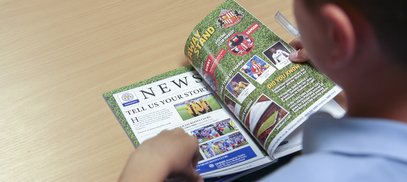Teachers often struggle to engage primary age students with writing news reports. Our colleagues at NewsWise have got six top tips to help you get great results!
When we talk to teachers who struggle to get good results with news writing, we always ask what their students have been writing about. Most often they’ve been given tasks such as, ‘Report on a UFO landing in the school playground’, or, ‘rewrite a fairytale in the style of a news report’. (These would no doubt challenge many trained adult journalists!)
However, we know that children are regularly exposed to real news, particularly online [1]. This news can feel exciting, worrying, sad, or heartwarming, but it never feels like a fairytale. Asking children to write ‘fake news reports’ can also be confusing when trying to teach them to be wary of ‘fake news’.
At NewsWise we’ve seen that when children are asked to write about real news events, they produce better writing. They are also much more motivated! Here are six top tips for turning your reluctant writers into news enthusiasts.
1) Keep it real
Get your students to write about real events in their school or local area, or encourage them to engage with global news.
- Ask children to report on something happening at school (a guest visitor, a new ‘vegan lunch day’ in the canteen), or a local issue (shops closing in the high street, a new park).
- Ask children to write about a local perspective on a national or international issue (coronavirus, climate change, Brexit).
- Plan opportunities for your students to conduct real interviews – they could talk to anyone from the head teacher to a local MP!
This is also a great opportunity to teach children about the importance of considering both sides of a story, and understanding the difference between fact and opinion. We’ve even heard of our lesson on ‘different viewpoints’ being used to resolve playground football disputes!
2) Keep it positive
We are all exposed to a lot of negative news, particularly during the coronavirus crisis. Producing upbeat news reports can help children rebalance their world view by becoming more aware of positive events. Our Happy News activity encourages children to script, report, and share their positive news.
3) Create an authentic experience
Why not transform your classroom into a newsroom? Your students will gain team work, time-management, and critical thinking skills.
There are plenty of free and easy ways to get that newsroom feel. Try getting your students to make their own press passes and a sign for the classroom door. Could you borrow some clocks and set them to different timezones? Make sure you assign roles. Who will ‘subedit’ the reports? Who is in charge of design? Of course, you can act as Chief Editor!
Set students short tasks with tight deadlines for an authentic newsroom experience. Teachers are often amazed that NewsWise students are able to critically assess reports, research and script a balanced news story from scratch and rehearse and perform a news bulletin, all within a couple of hours.
4) Immerse students in news
Many children cannot access news at home, particularly those in disadvantaged areas [2]. How can we expect children to write in the style of news reports without exposure to news media? Remember that your classroom might be the only source of news for your students. Make time for them to watch, listen to, or read the news.
Check out our child-friendly news page here for more ideas on bringing real, age-appropriate news into the classroom.
5) Give pupils agency
Children are more motivated to write if the topic interests them. NewsWise teachers who let children choose their own writing topics even reported children asking to continue working over lunchtime!
Of course, as Chief Editor of your newsroom, you can veto any topic you consider too risky. Every newsroom has an editorial meeting where story ideas are discussed and the best ideas are taken forward. Could you do the same?
Empowering your pupils to report on real issues that matter to them will give them a unique voice in their school and community. As Roz, a teacher in London, told us:
It was watching them link what they were doing in class to wider issues outside our school community which I found the most gratifying. For me, so much of what NewsWise brings up in its delivery is to do with exploring what sort of person you want these children to become: compassionate, interested, resilient, critical, brave, truthful.
6) Create a purpose
Real news deserves a real audience. Get your students to create a school newspaper, take over the school newsletter for a week, or organise a presentation event for their families. You can even send your students’ writing to NewsWise to feature on our website!
We hope these tips inspire you to change the way you teach news writing at primary level. As Jess, a teacher in Slough, told us:
[NewsWise] was transformative in the way that we talk about and teach the news at Claycots; we now aim to ensure that children are learning about the purpose of news as well as being able to produce news stories that are real and trustworthy
By Angie Pitt, Director & Vicky Baker, Programme Manager, NewsWise
NewsWise is a free news literacy project for 9-11 year olds, from the Guardian Foundation, National Literacy Trust and PSHE Association.
[1] Ofcom: Children and parents: Media use and attitudes report 2019
[2] National Literacy Trust: Family News Literacy Report, 2019
